IT people on vacation: what about the telescope?
 Bashny.Net
Bashny.Net
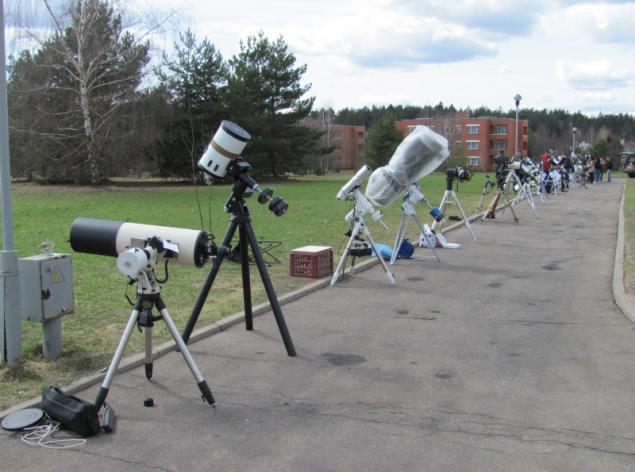
Have you read post that observe the sky , seeing yourself and show your friends are interested in the topic. The logical next desire - to buy a telescope and look at the same beauty is already well to the naked eye. But this task is not as simple as it may seem, the choice depends on various parameters. Therefore, a post describing the various optical systems of telescopes, mounts, I think, will be useful.
Necessary demotivation and objects for observation h4> To not felt sorry for the money spent, it is necessary to make a few discourages entry.
The Human Factor h5> In the first place, we must understand that the amount and quality of beauty depends on your efforts. Astronomy does not belong to the entertainment of the "press a button and enjoy." It is necessary to think of ways to answer the following questions:
- Budget. The cost of additional accessories will be comparable and easily exceed the cost of the telescope, keep this in mind when forming the budget constraints on the cost model.
- Location observations. Where do you plan to watch? The city from the balcony, in the country, to leave the city to the countryside, into the wilderness or even abroad?
- Storage and transport. B> Where and in what form you are going to store the telescope? As transport to the place of the observations from the previous paragraph? How often? How to pack and on what type of transport to transport?
- the desired object of observation. B> Are there any types of objects that you really want to watch?
- Format observations. You are going to be observed visually or practice astrophotography? Will be observed alone, with family / friends / associates? It is also highly desirable to get a personal experience observing through a telescope. There are many ways to do this:
- Ask around friends, who have all of a sudden?
Technology surpassed human h5> Secondly, we should not stir up a photo of the nebula with the Hubble Space Telescope, this you will not see. Unfortunately, the human eye can not accumulate the photons as a film or a matrix camera and night vision badly distinguishes colors. So what you will see in person, as a rule (there are exceptions!), Will look worse than the photo from the Internet. So I made a small list with illustrations will look like objects in the telescope. The list is sorted by simple observation and subjective beauty facilities.
Moon h5> The Moon - is one of the few objects that are visually more impressive than in the photo. The eyepiece moon is very bright, clear, visually very big, and very beautiful. It is best to observe the moon in the first and last quarters (ie, when about half of the visible disk). In this case, a boundary between light and shade (the terminator) is very well visible relief - craters different height roughness seas and other beauty. The moon - this is the easiest and visible object, which can be seen every month, is changing every day and never get bored. I took a photo Tver astrokluba and several edit it to create the most similar species:
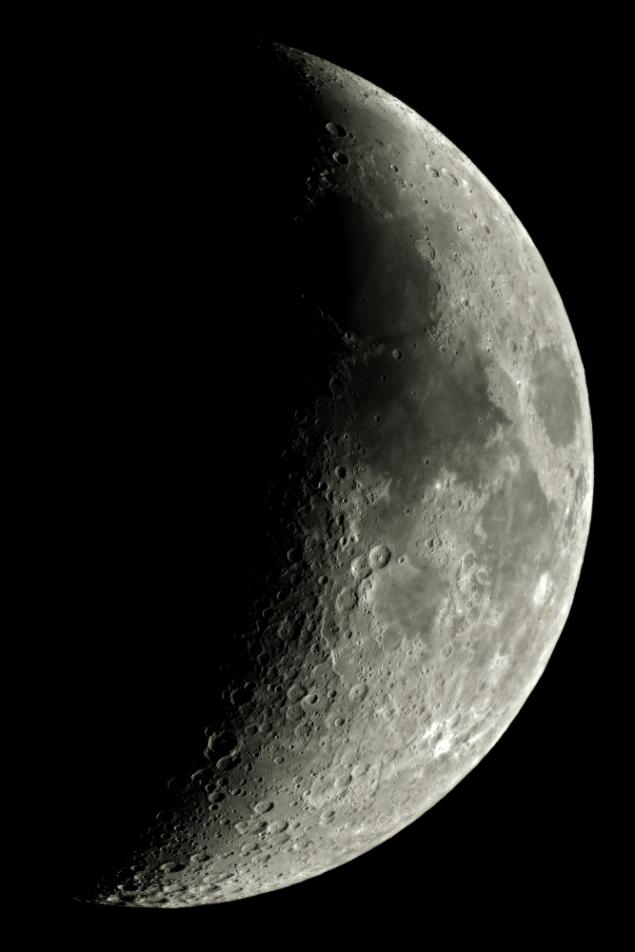
At high magnification, you can look at some beautiful landscape elements, such as Rainbow Bay:
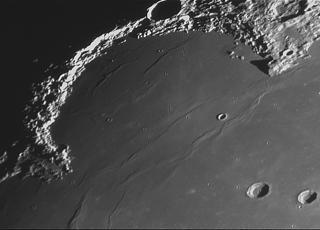
Planet h5> The second type of access to facilities. Planet replace each other on a schedule, so this cycle is unlikely to get bored, but, alas, in amateur telescopes, they can be seen far worse than astrofoto, not to mention photos from observatories, interplanetary spacecraft and Hubble.
Jupiter

If you look closely, we see two bands on the disk. This photograph had their pririsovyvat have eyes the best dynamic range than that of a simple amateur astrofoto. I>
Saturn

Venus

Mars

Mercury and Uranus are far in the area of disappointment. If strongly interested, you can find them, but look especially not on that.
Multiple Stars h5> The telescope has seen the color of stars. And if colored double star, it is very beautiful. The brightest representatives - Albireo in Cygnus and Cor Caroli in Canes Psah.

Albireo, for a better perception of color may be slightly defocus the telescope. i>
Open clusters h5> Open clusters - this is the second type of objects that impresses more than their pictures. For the first time he saw Hee / Al Perseus telescope one of my friends remembered final "A Space Odyssey" - "Oh! It's full of stars! »
The Pleiades

Hi / Al Perseus
Very nice two open clusters near:

No, I still watch live better i>
Globular clusters h5> Here everything is sad. In amateur telescope globular clusters seen as dull spots, but if you're lucky with the conditions of observation, it still can be seen that they are formed by thousands and millions of stars.
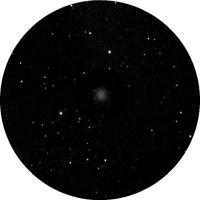
Big cluster of Hercules. i>
Nebula h5> Here everything is very sad. Due to the properties of the eye nebula, first, black and white, and secondly, very slightly visible, thirdly, we must go far beyond the city in the dark room to see them more or less visible.
The Orion Nebula
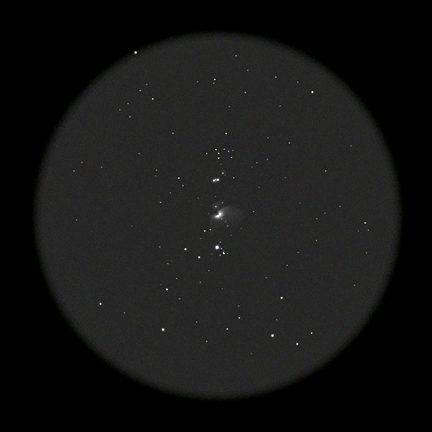
M57. Nebula "Ring" in Lira

And do not say that you do not see anything here. i>
Sun h5> By purchasing a special filter, it is possible to look at the sun. In conventional filter visible sunspots, granulation (looks like a gridded surface).
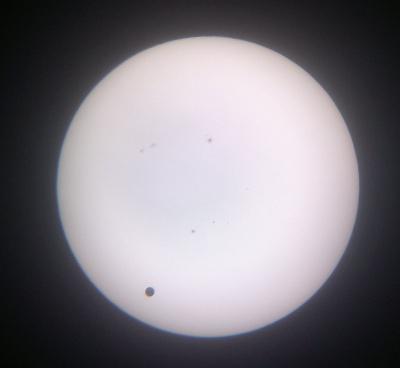
Prohodenie Venus, 2012, at the top of visible sunspots. i>
NOTE: In the absence of a special filter, do not point the telescope at the sun. Perhaps meltdown or explosion set of eyepieces and irreversible blinding eye when you try to look through the eyepiece. Using the sooty glass cooking foil or other surrogates instead of a special solar filter is unacceptable!
Other h5> With some luck and skill, you can watch the planes flying past, the ISS (four rows of solar panels is quite distinguishable), lanterns and so on.
Also pay attention to the plug "eyepieces", the shipped Stellarium. If you enter the parameters of the telescope and eyepiece, Stellarium will show the size of the object in the eyepiece.
Materiel h4> To objectively talk about telescopes, it is necessary to understand what telescopes are and what the advantages and disadvantages of.
Definitions h5> Aperture - the diameter of the primary mirror of the telescope. In simple terms, the larger the aperture, the better you can see. The maximum real increase in the telescope - two apertures. In real life, the telescope is rarely used on an increase of more 150-200, do not chase the increase. Also, the atmosphere is rarely good enough for telescopes with an aperture greater than 300 mm able to fully express themselves.
The focal length - is the distance at which the telescope building image of an infinitely distant object. Knowledge of the focal length is necessary to calculate the increase in ocular increase - is the focal length of the telescope divided by the focal length of the eyepiece. For example, a telescope with a focal length of 900 mm 10 mm eyepiece will increase 900/10 = 90. Please note that the telescope with a small focal length is very short-focus eyepieces require to achieve the highest gains. For example, a telescope with an aperture of 114 mm and 500 mm focal length eyepiece will require 2, 5 mm to increase its maximum. These eyepieces are expensive and inconvenient for observation (details below)
Aperture - is the ratio of the aperture to the focal length. Important for astrofoto option, it can be roughly compared with the iris of the camera. For visual observations matters is that the relative aperture telescopes with less than 1/6 gets distorted at the edge of the eyepiece.
heat setting
Adjustment - the process of combining elements of the optical axes of the telescope. Depending on the design, it can be done at the factory for life, or she would have to deal with on their own with some regularity.
Optical telescopes scheme h5>

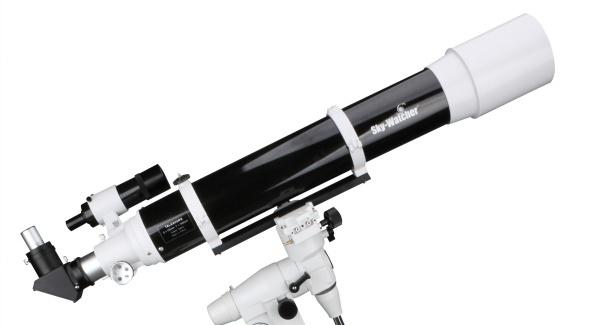
Refractor , also known as refractor. Historically, the first type is widespread so far. Modern refractors exist in two forms - achromats and apochromat. Achromatic correct all image distortion (aberration), in addition to the chromatic. They are cheap, but the objects observed in them, have colored edges, which degrades the image. Apochromat and eliminate chromatic aberration, but are much more expensive.
Advantages:
Minimum maintenance. Factory adjustment is maintained over the years, the tube is closed from dust and moisture. Extremely fast thermal stabilization. Aperture works completely (no elements blocking the part of the aperture in the pipe), a large contrast of the image li > Disadvantages: Chromatic Aberration to achromatic price for apochromat. Do not come in large aperture (larger lens is very difficult and expensive to make). 150 mm is already very expensive, large aperture almost never. The length of pipe (can be a disadvantage)

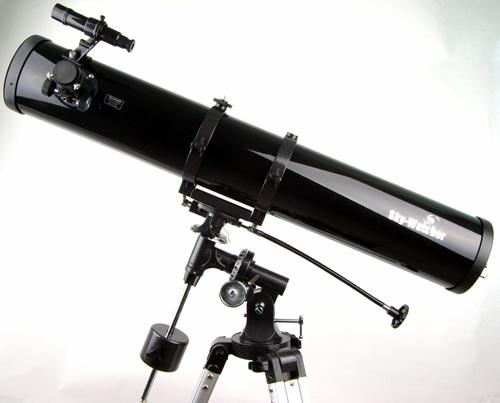
Reflector , also known as the reflecting telescope. Newton was created as a solution to the problems of the then refractor. Despite the presence of the other mirror circuits, namely Newton's scheme is very popular right now.
Advantages:
The absence of aberrations, excellent image quality. The cheapest millimeter aperture - with increasing aperture reflectors more and more in relation to other schemes. short time thermal stabilization, which, however, increases with the size of the telescope. Disadvantages:
The secondary mirror with holders "eats" part of the aperture. Stretching of the yield characteristic "Ray" star on astrofoto. Open the tube. Over time, the mirror is polluted with dust. The need for adjustment. After transporting the alignment of the reflector can lose, and it needs to be rebuilt. Fortunately, the experience is a matter of a few minutes.

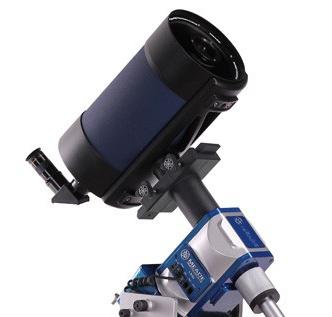
Katadioptrik , also known as the mirror-lens telescope. It appeared in the 20th century. By the way, along with the names of Galileo and Newton telescope scheme perpetuated domestic astronomer Максутова, the inventor of one of the most popular schemes mirror-lens telescopes - Maksutov-Cassegrain scheme.
Advantages:
Compact. The shortest telescopes. Closed pipe keeps the mirror from dust. The absence of aberration. Disadvantages
Less contrast image for the area of the central screening aperture does not work completely. The most expensive millimeter aperture. A great time thermal stabilization.
Prybars h5> mount - is an adapter between the telescope and tripod. From it depends on how comfortable you will be observed as weights with a carry, and how much will shake the telescope for observations.
In basic design of the mount is divided into alt-azimuth and equatorial.

Alt-azimuth mount has two axes - azimuth and altitude, hence the name. It ignores the fact that the Earth's axis is at an angle to the horizon.
Advantages:
A simple, easy, weight lifting. We do not need additional training to observations. Disadvantages: The object should be accompanied by two axes. The object turns slowly into view, it complicates astrophotography. As a rule unsuitable for observation area zenith. A little away is the alt-azimuth mount Dobson, details about it will be lower.
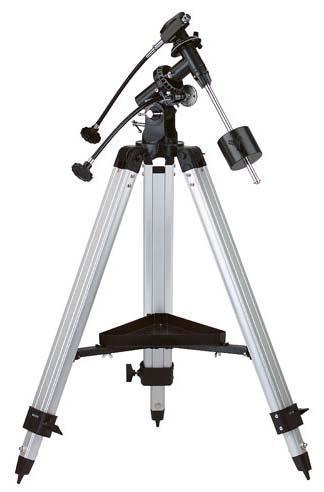
Equatorial , it is also a German, the mount has a third, additional axis, whereby it can be set parallel to the axis of rotation of the Earth.
Advantages:
object is simply to accompany the manual, even for a budget mounts have a place to mount the simple motor, which greatly facilitates the maintenance of the object. There are no problems with the availability of the zenith. The field of view remains fixed, it's good for astrofoto. Disadvantages:
The mount is more complex and difficult, the structure includes a very heavy counterweight. The mount requires additional operations before observations and after them. also mount can be motorized and computerized.
In the simplest version of equatorial mount equipped with analog or digital motor to follow an object. Aiming is done by hand. A more complex version - it drives on both axis of the mount, allowing to direct the telescope at the object from the remote (if available port from a laptop with the appropriate software) and follow it automatically. The most difficult option - computerized mount with the base objects, capable of self-induced on the object and to accompany him. The most advanced mount can be equipped with GPS / GLONASS and compass for fully automated preparation for observation.
Precautions h4> What mistakes you can make when choosing a telescope?
Purchase telescope hypermarket
too greedy
Newton corrector
Short-refractors-achromats
selection logic h4>
If you have a clear idea of their desires and limitations, the choice will not be very difficult. There are a few common scenarios that may be mentioned.
Balcony sightings in the city h5> To monitor the balcony is important compact telescope. Therefore, on a limited budget are preferable on an azimuthal mount refractors - refractor at most of the pipe will stick out, and with azimuthal mount is easier to handle. If a lot of money, you can think about katadioptrike on motorized mount. In any case, do not chase much aperture of 100-150 mm for the city is enough. However, these tips are advisory, I am quite successfully operated on the balcony of a reflector on an equatorial mount, because when choosing a telescope I wanted a large aperture without chromaticity on a limited budget, and has been planned for the purchase of a drive mount.
P.S.
Tags
See also
Suicidal few secrets of sales, or how to sell snow to Mount Fuji.
10 signs that we live in a matrix.
What a rocket engine is the best?
How to survive the winter on their products
Scientist Stuart Russell on artificial intelligence
NEWSPAPER Manicure!
Most friendly whales in the world
A man with whom it is impossible LONG HEALTHY RELATIONSHIPS
What to do if you are bitten by an energy vampire?

































